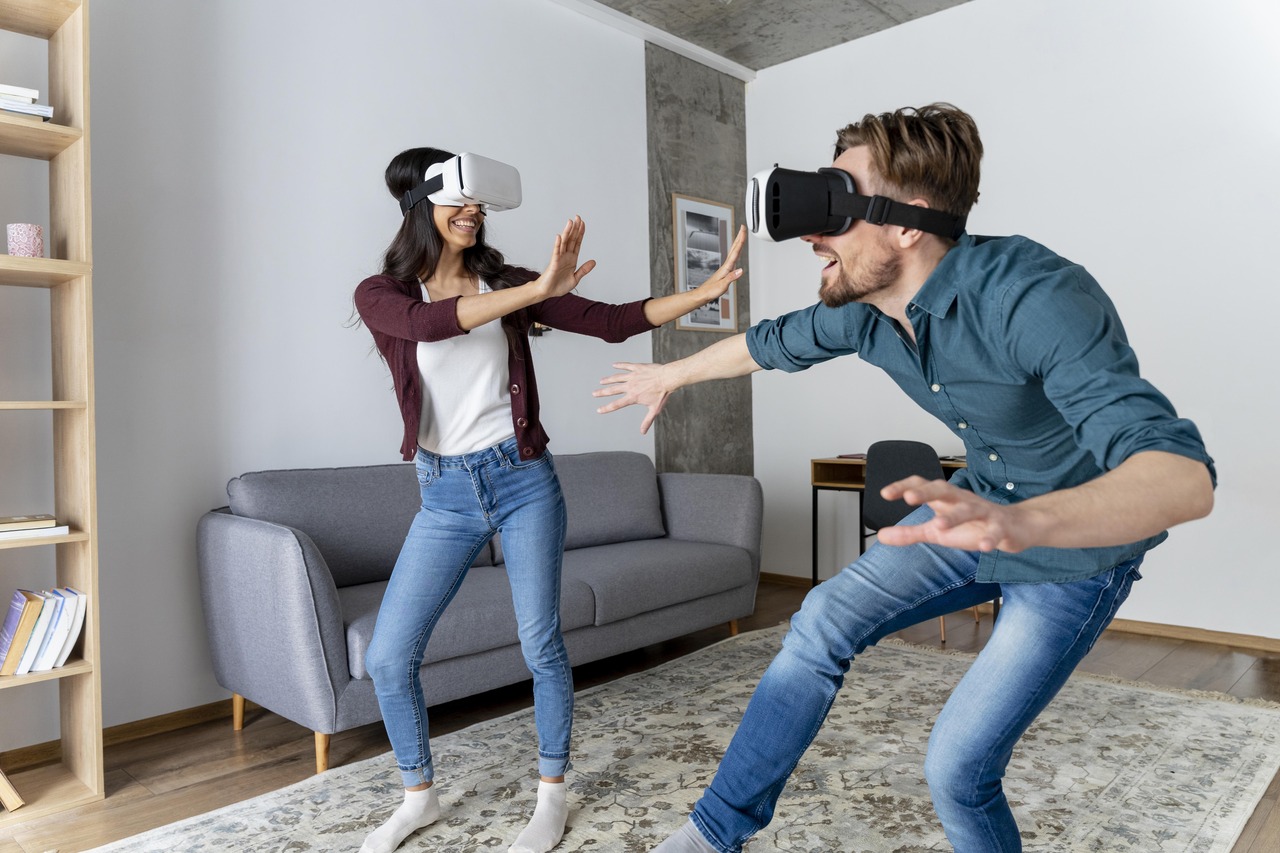Immersive technology, especially augmented reality (AR) and virtual reality (VR), is one area where technology is changing faster than ever before, pushing the limits of what we can imagine. Even though they look like they are from the future, both are already changing how we connect, work, play, and learn. But what exactly makes AR different from VR?
In this blog, we will explain the dissimilarities between AR and VR, their workings, and the reasons behind their significant influence on the direction of digital experiences.
What is Augmented Reality
Augmented reality have to merge the virtual and real worlds. It improves your physical surroundings with digital layers rather than replacing what you can see. Let’s imagine using the camera on your phone to see directions flying over the road while you are walking or furniture appearing in your living room out of nowhere so that is how AR wo
AR doesn’t require costly equipment. You can incorporate virtual elements into your world with just your smartphone, tablet, or AR-enabled glasses. AR is becoming more and more prevalent in daily life because it is interactive, useful, and convenient and growing fast in everyday life.
Common Uses of Augmented reality
- Before purchasing a sofa, we will check how it will fit in your house or check clothe.
- View current directions superimposed on buildings or roadways.
- To improve learning, visualize 3D molecules or human anatomy.
- Check real-time guidance while fixing equipment.
- Use of AR games like Pokémon Go, filters, and effects.
You can see more and understand faster, and experience more deeply with AR without losing awareness of your surroundings.
What is Virtual reality
Virtual reality takes you to an entirely different new world, whereas augmented reality improves it. When you wear a headset then you are not sitting in room instead it transports you on a different location, such as Mars, the ocean, or a medieval castle. Virtual reality (VR) make a completely immersive experience that replaces a computer-generated environment for your actual one.
If you want to enjoy Virtual Reality then you need wear a specialized gear, including motion controllers, VR headsets (such as Meta Quest, HTC Vive, or PlayStation VR), and sometimes haptic gloves. To give you the impression that you are really “inside” the virtual world, these tools track your actions and movements.
Common Uses of Virtual Reality
Step directly into your favourite games for a life-like adventure.
- Feel comfortable operating heavy machinery, flying airplanes, and performing surgeries through practicing it.
- Go on virtual field trips in geography, science, or history.
- Participate in design sessions or virtual meetings in shared 3D environments.
- Discover cities or properties virtually without to be present there.
- Complete immersion is provided by VR, a space where experience and imagination meet.
The Main Dissimilarities between AR and VR
Both AR and VR are unique in their own ways one heightens reality and the other recreates it.
| Aspect | Augmented Reality (AR) | Virtual Reality (VR) |
| Immersion Level | Partial- real and digital coexist | Total – fully virtual environment |
| Reality Interaction | Adds virtual elements to the real world | Replaces the real world entirely |
| Devices Used | Smartphones, tablets, AR glasses | Headsets, controllers, motion sensors |
| Mobility | High – users stay aware of surroundings | Limited – users are isolated |
| Cost | Affordable and accessible | Higher cost and setup requirements |
| Use Cases | Shopping, training, education, daily use | Gaming, simulations, immersive learning |
Technologies Transforming Industries today
- Students can now learn through visualizing lessons instead of just reading them. They can use AR to dissect virtual frogs without hurting real ones or to explore the solar system in three dimensions. VR, on the other hand, makes learning more engaging and efficient by allowing them to study inside the human body or go back in time which makes learning more exciting and effective.
- Augmented reality improves accuracy by facilitating surgeons to cover up digital images during actual surgeries. However, through immersive experiences, virtual reality (VR) helps patients overcome anxiety, phobias, and even chronic pain through therapy and pain management.
- Augmented reality has completely changed online shopping, allowing you to virtually try on makeup and arrange furniture in your room before buying. By establishing virtual showrooms where clients can examine products in a way never possible before, virtual reality is also revolutionizing marketing.
- Virtual reality gaming has completely changed about how players interact because players are living the story instead of just watching it. Consider social media filters, AR-based concerts, or interactive museum displays as examples of how AR adds entertaining layers to everyday life.
- VR enables designers to develop and test 3D prototypes prior to production, saving time, money, and materials, AR gives technicians and engineers access to real-time data overlays.
- AR and VR are no longer just cool tech demos instead they are becoming part of everyday life. Everyone using AR to train employees, doctors are using VR to simulate surgeries, and students are learning through interactive, 3D experiences.
Trends which are shaping future for AR and VR
Immersion technologies appear to have a very bright future. This year’s trends are as follows:
- AR and VR are becoming smarter by using artificial intelligence. AI enables AR to identify objects in the real world and modify overlays appropriately. It creates more realistic simulations and responsive environments in virtual reality.
- Companies like Meta and Google are leading the race with stylish, lightweight AR glasses. Google’s Android XR platform and Meta’s Ray-Ban smart glasses are revolutionizing hands-free and effortless digital interaction.
- Digital twins, or virtual versions of actual machinery and spaces, are being created by factories and industries by combining AR, VR, and IoT. These help businesses in real-time performance monitoring, forecasting, and optimization.
- By 2033, the VR market is predicted to have grown from $43 billion in 2024 to almost $380 billion. Because AR is accessible and has practical applications, it is also being widely adopted in the retail, healthcare, and educational sectors.
- Modern virtual reality equipment can simulate temperature and touch, producing realistic experiences that feel very real. With experimental gadgets that enable users to “feel” digital textures in actual settings, AR is doing the same.
AR or VR: What Fits You Better?
Depending on your needs, yes
- If you want to improve your real-life tasks, like training, map reading, or shopping, go with augmented reality.
- If you want to complete immersion, go for virtual reality (VR) then it’s perfect for simulations, gaming, and education.
Both technologies collaborate in many industries under the more general heading of Extended Reality (XR), producing potent hybrid experiences that bring together the best aspects of both technologies.
AR and VR are Shaping the Future
AR and VR are the next phase of digital development and it is not just sci-fi dreams. From all phases of life from students to all kinds of fields, we will soon live in a world where digital and physical realities coexist harmoniously as technology gets lighter, faster, and AI-powered. Virtual Reality encourages imagination, whereas AR provides facts. Both are changing how individuals view and interact with the world.
- Augmented reality make it more engaging by adding digital images and information to the real environment.
- Virtual reality introduces us to new things by putting us in fully digital worlds that are quite different from the ones we live in.
- AR and VR are leading the XR revolution, making employment, learning, stories, and technological experiences more real.
- With AI, 5G, and photorealistic 3D capture, we are getting closer to experiences that thought to be distant to achieve. They achieve this by adding layers, headgear, and imagination to reality.
Conclusion
Virtual and augmented reality are interchangeable terms. The first takes us away from reality, while the second improves it. These technologies are altering how we perceive things, communicate, learn, and live. The question of the future is not whether to use AR or VR instead it is how well they will collaborate to create experiences that we could only imagine previously.








Leave feedback about this